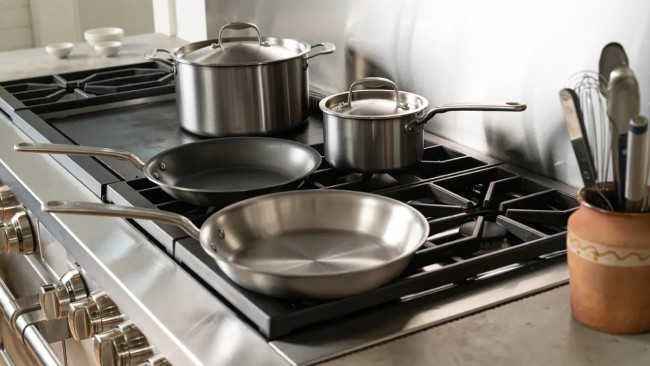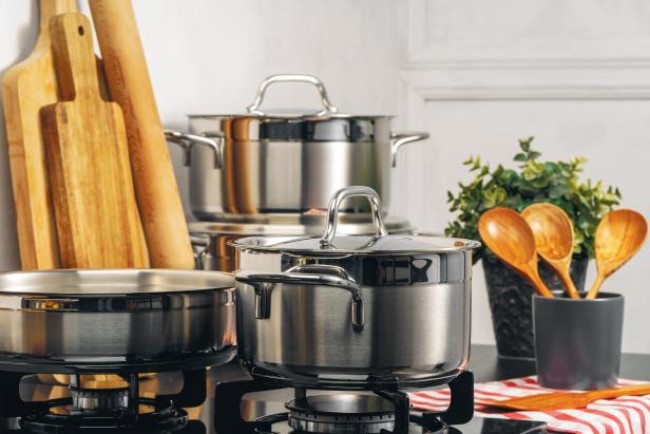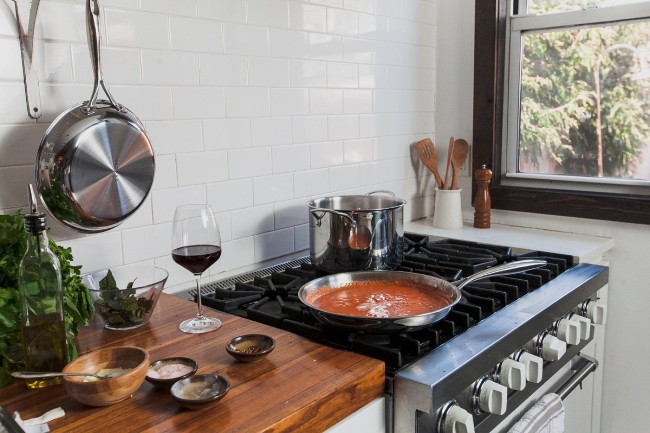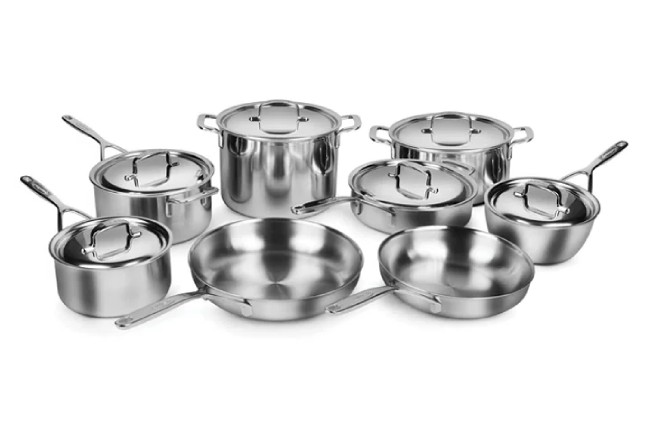How to Care for Your Stainless Steel Cookware on Gas Stoves? Stainless steel cookware can last a lifetime when used correctly. Stainless steel is an excellent option if you’re looking for durability and heat conduction from your cooking utensils. With proper care, these pots and pans will bring out the best in your recipes.
Whether using gas stoves or electric burners, caring for stainless-steel cookware starts with understanding how it works and its unique characteristics. Here you’ll learn how to properly use your stainless steel on gas stoves properly, ensuring its shine stays intact over time!
Understanding Your Stainless Steel Cookware
Detailed Explanation of Stainless Steel Material
Composition and Durability: The durability of stainless steel is due to its chromium content. Chromium creates a thin, invisible oxidized film on the surface of the steel that prevents further oxidation and corrosion. This allows stainless steel to withstand extreme temperatures and prevents it from transferring flavors or odors.
Advantages and Disadvantages: Stainless steel is an excellent choice for cookware as it is heat conductive and very durable. It can be used on all types of cooktops, including gas ranges. However, stainless steel may scratch and dent easily and is more expensive than other materials used to make cookware.
Recognizing Quality Stainless Steel Cookware
When looking for stainless steel cookware, looking for pieces made from high-quality materials is essential. Good quality stainless steel should be thick and heavy with a smooth, seamless finish. The bottom of the pan should be flat, and even so, heat can distribute evenly throughout the cookware when placed on a gas stovetop.

Brief Overview of Gas Stove and Its Compatibility with Stainless Steel
Gas stoves are the most popular type of stove because they are quick and even heating, perfect for cooking with stainless steel cookware. Gas stoves don’tdon’t require you to preheat them as much as other stoves and can reach higher temperatures faster. However, they can also cool down much quicker than other stoves and require consistent temperature control.
How to Care for Your Stainless Steel Cookware on Gas Stoves?
For best results, use stainless steel cookware for gas stoves. Stainless steel offers superior heat distribution and is durable enough to handle the high temperatures of a gas stove. However, stainless steel cookware requires proper care to ensure it lasts for years. Here are some tips for caring for your stainless steel cookware on gas stoves.
- Use medium heat when cooking with stainless steel cookware on a gas stove; high temperatures can cause the stainless steel to warp and discolor.
- Preheating the cookware before adding food is essential, as this will help prevent the sticking and burning of food.
- Make sure to clean the stainless steel cookware after every use. Rinse it with warm water and a mild detergent, then dry thoroughly to prevent rusting or discoloration.
- If food does stick, use a plastic scrubber to remove residue gently. Do not use metal scrubbers, which can scratch the cookware’scookware’s surface.
- Avoid cooking with acidic ingredients, such as tomatoes or fruit juices, as they can cause discoloration of the stainless steel.
- Store your stainless steel cookware in a dry place to prevent rusting and discoloration. If needed, lightly coat the cookware with vegetable oil before storing it to protect it from moisture.
With proper care, your stainless steel cookware can last for years. Follow these tips and enjoy your stainless steel cookware on your gas stove for many years.
The Basics of Stainless Steel Cookware Maintenance
Initial Cleaning After Purchase
Before using your stainless steel cookware for the first time, thoroughly wash it with hot soapy water. This will help to remove any shipping dust and debris that may have been left behind during manufacturing and shipping processes.
Everyday Cleaning Tips
To clean stainless steel cookware:
- Use a mild detergent and warm water.
- If you have harsh food residue that won’twon’t come off with regular cleaning, make a paste of baking soda and water and apply it to the problem area.
- Let it sit for 10 to 15 minutes before wiping it away.
Always dry your stainless steel cookware after cleaning, as water can cause spots and corrosion if left on the cookware while not in use. Use a soft cloth or paper towel to remove excess moisture.

Recommended Cleaning Products and Tools
Using the right tools and products is essential when cleaning your stainless steel cookware. Avoid using abrasive or scouring pads, as these can scratch the surface of your cookware.
Consider investing in a nonabrasive cleaner such as Bar Keepers Friend or Bon Ami for tough stains. Soft cloths are also recommended for cleaning and drying stainless steel cookware.
Advanced Care Techniques: Going Beyond the Basics
Handling Burnt or Stuck-On Food
Prevention and Precautions: Make sure your flame is not too high. A gas stove can create more intense heat than an electric stove, so if you are used to using higher temperatures with electric cookware, you should be careful when using it on a gas stove.
Step-by-Step Guide to Removing Burnt Food:
- Remove as much food residue as possible using a nylon or plastic spatula. Never use metal utensils to avoid scratches on your stainless steel cookware.
- Fill the pan with warm water and add two tablespoons of baking soda; let it soak for 15 minutes.
- Check the pan for any remaining residue. Scrub the affected area with a nonabrasive cleanser and a damp sponge or nylon brush if needed.
- Rinse your pan thoroughly after cleaning, and dry it before storing.
Dealing with Discoloration and Stains
Recognizing Different Types of Stains:
- Brown or Black Stains: These are caused by overheating food and can be removed with a vinegar solution.
- White Spots: These are caused by calcium deposits and can be removed by soaking the pan in a water and vinegar mixture.
- Blue-Green Discoloration: This is caused by an interaction between iron and chlorine, which can be removed with a mixture of lemon juice and water.
Best Methods to Remove Each Type of Stain:
- Brown or Black Stains: Soak the pan in warm water and white vinegar for 15 minutes. After soaking, scrub the affected area with a nonabrasive cleanser and a damp sponge or nylon brush. Rinse thoroughly and dry before storing.
- White Spots: Fill the pan with warm water and add one tablespoon of white vinegar. Allow the solution to sit for 15 minutes, then scrub the affected area with a nylon brush. Rinse thoroughly and dry before storing.
- Blue-Green Discoloration: Fill the pan with warm water and add lemon juice until completely submerged. Let it sit for 15 minutes, then scrub the affected area with a nylon brush. Rinse thoroughly and dry before storing.
These advanced care techniques should be used in addition to the primary care methods mentioned previously. If done correctly, stainless steel cookware can last many years and perform excellently on a gas stove.
Removing and Preventing Water Spots
Water spots can be unsightly and difficult to remove. To prevent them from occurring in the first place, rinse and dry your cookware with a soft cloth after every use.
Step-by-Step Guide to Removing Water Spots:
- Fill a sink or container with warm water and add two tablespoons of baking soda.
- Submerge the stained pan and let it soak for 15 minutes.
- Use a soft cloth to scrub the affected area in a circular motion.
- Rinse and dry the cookware before storing it.
These simple steps should help remove water spots from your stainless steel cookware. Still, it requires careful attention and regular maintenance to ensure your cookware is always in top condition.

Preserving Your Stainless Steel Cookware: Dos and Don’ts
Safe and Unsafe Practices When Using Gas Stoves
Using a gas stove to cook can enrich any home chef’s experience. Whether you’re looking to prepare a simple meal or host a dinner party, your stainless steel cookware will help you achieve the desired outcome.
However, you must take proper care of your cookware to get the most out of it. Here are some dos and don’ts when preserving your stainless steel cookware on a gas stove.
Dos:
- Always preheat the pan before adding oil or food. This helps ensure your food doesn’tdoesn’t stick, burns evenly, and is cooked properly.
- Use the correct heat setting for your food – too high or too low of a gas flame can cause problems. Begin with medium heat and adjust as needed.
- Clean your cookware immediately after use to avoid having food residue dry on the pan, making it harder to clean later.
- Hand wash your cookware using warm water and a soft cloth or sponge.
- Dry your cookware thoroughly with a clean cloth to prevent water spots.
Don’tsDon’ts:
- Don’tDon’t use steel wool, abrasive detergents, or harsh scrubbing pads when cleaning your cookware, as these can damage the pan’span’s surface.
- Don’tDon’t use high heat when cooking, which can cause uneven heating and warping.
- Don’tDon’t put cold cookware onto a hot burner, which can crack the pan.
- Avoid using non-stick sprays on stainless steel cookware, as they can create a sticky residue, making cleaning more difficult.
- Avoid using metal utensils on your cookware, which can cause scraping and scratching.
By following these simple dos and don’ts, you’ll be able to preserve the quality of your stainless steel cookware while also achieving delicious results. With proper care, your stainless steel cookware will provide you with years of use and enjoyment.
Products to Avoid When Cleaning Stainless Steel Cookware
While several cleaning products are available on the market, some contain harsh ingredients that can damage your cookware. Here’sHere’s a list of products to avoid when caring for your stainless steel cookware:
- Abrasive detergents or soaps
- Chlorine bleach
- Steel wool
- Harsh scrubbing pads
- Non-stick sprays
Importance of Regular Maintenance
Finally, it’s important to remember that regular maintenance is critical to getting the most out of your stainless steel cookware. Ensure you clean your cookware immediately after use to avoid having food residue dry on the pan, and always follow the dos and don’t list above.
In addition, if there are any visible scratches or signs of damage, replace your cookware as soon as possible to ensure you get the most out of it.
By following these simple tips and guidelines, you can enjoy better cooking results while preserving your stainless steel cookware for years. With proper care and maintenance, your stainless steel cookware will continue providing an enjoyable cooking experience.
FAQ about How to Care for Your Stainless Steel Cookware on Gas Stoves?
What Causes Discoloration on Stainless Steel Cookware?
Discoloration can occur due to a reaction between the heat and the metal when using stainless steel cookware on gas stoves. This is because stainless steel contains Chromium and Nickel, which react with oxygen when heated. Discoloration usually occurs in the form of a brown or blue stain.
Can I Use Abrasive Materials to Clean My Stainless Steel Pots and Pans?
No. Abrasive materials will only damage the stainless steel surface, making it more prone to discoloration and wear and tear over time. Instead, You should use nylon or soft-bristled brushes to clean off any dirt or residue on your cookware gently.
Why Does My Stainless Steel Cookware Have a Rainbow Discoloration After Heating?
This is called the rainbow effect and occurs due to oils or fats in your cookware heating up and reacting with the metal. The best way to avoid this is to avoid using too much oil when cooking and ensure that any food residue is wiped off before placing it on your stove.
Can Stainless Steel Cookware Go in the Dishwasher?
Yes, it is safe to put stainless steel cookware in the dishwasher as long as the pieces are dishwasher-safe. You should check the manufacturer’smanufacturer’s instructions before using your cookware in a dishwasher.
Conclusion on How to Care for Your Stainless Steel Cookware on Gas Stoves?
To ensure that your stainless steel cookware lasts a long time, it is essential to take care of it properly. This includes avoiding abrasive cleaning materials, wiping off any food residue before heating the pot or pan, and not adding too much oil when cooking.
Additionally, check the manufacturer’smanufacturer’s instructions if you intend to put your cookware in the dishwasher. Proper care and maintenance ensure your stainless steel cookware can last many years!
Related post:

